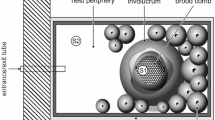Abstract
The present paper reports on behavioral experiments and gas chromatographic analysis of chemical communication in the mating biology of the primitively eusocial sweat bee Lasioglossum (Evylaeus) malachurum. In a dual-choice experiment, a female made odorless was significantly less attractive than an untreated one. Attraction in L. (Evylaeus) malachurum is therefore mediated by a female-produced sex pheromone. Further bioassays showed that unmated gynes are more attractive to males than mated ones. Males are able to differentiate between the two groups of females as little as 3 h after mating. Biotests with different samples obtained from attractive gynes showed surface extracts to be most attractive. Behavioral tests with synthetic copies of the compounds identified as cuticular constituents of virgin gynes were highly attractive to males; the volatile bouquets consisting of n-alkanes, n-alkenes and iso- pentenyl esters of unsaturated fatty acids were the most attractive samples. Isopentenyl esters of unsaturated fatty acids were the key compounds in inducing male inspections as well as stimulating pounces and copulatory attempts. Virgin and nesting gynes differed clearly in the relative and absolute amounts of the volatiles on the cuticle. The total amount of volatiles was significantly higher in virgin gynes and decreased in breeding queens. Hydrocarbons were the dominant group of compounds in both groups of females. The relative amounts of the wax-type ester, hexadecyl oleate, iso- pentenyl esters, and a hitherto unidentified steroid were higher in attractive virgin gynes, while the relative proportions of hydrocarbons and lactones dominated in nesting queens. The site of sex pheromone production in attractive young L. (Evylaeus) malachurum gynes remains unknown. Head glands or Dufour's gland secretions may be involved. Another possible source of the `active principle' found among the cuticular lipids could be glandular cells of the epidermis. The significance of modulation of female sex pheromone composition is discussed in terms of a reduction in mating expenditures.
Similar content being viewed by others
Author information
Authors and Affiliations
Additional information
Received: 30 April 1998 / Accepted after revision: 24 July 1998
Rights and permissions
About this article
Cite this article
Ayasse, M., Engels, W., Lübke, G. et al. Mating expenditures reduced via female sex pheromone modulation in the primitively eusocial halictine bee, Lasioglossum (Evylaeus) malachurum (Hymenoptera: Halictidae). Behav Ecol Sociobiol 45, 95–106 (1999). https://doi.org/10.1007/s002650050543
Issue Date:
DOI: https://doi.org/10.1007/s002650050543




